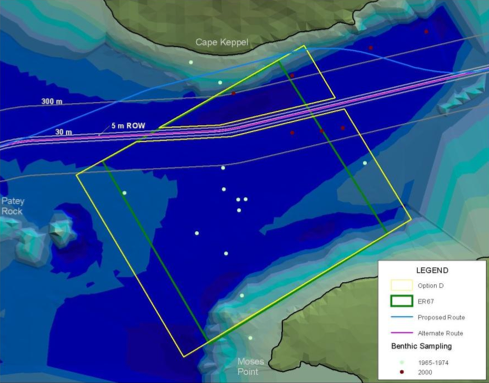
News/Reports
Independent Assessment of Satellite Channel Ecological Reserve #067: With Respect to the GSX Pipeline
Satellite Channel Ecological Reserve #067 (ER67), located between Saltspring Island and Saanich Peninsula, was designated in 1975 to conserve rich benthic communities typical of fine-grained, level-bottom environments in the southern Gulf Islands (Figure 1). Under the Ecological Reserve Act, industrial uses are prohibited in ecological reserves (ER) to protect the environmental values associated with these special areas for future generations.
Here is a link to the final report called: “Independent Assessment of Satellite Channel Ecological Reserve #067: With Respect to the GSX Pipeline“.
Link to additional data and maps: http://a100.gov.bc.ca/pub/acat/public/viewReport.do?reportId=17780.
Georgia Strait Crossing Pipeline Ltd. (GSXPL) wants to explore the possibilities of putting a pipeline through Satellite Channel Ecological Reserve #67 (ER67). ER67 is located between Saltspring Island and Saanich Peninsula and was designated in 1975 to conserve rich benthic communities. This report is a detailed evaluation of the site and environmental implications of the proposed options on the long-term well being of the reserve.
Author: AXYS Environmental Consulting Ltd.
Date Published: Mar 2002
Report ID: 17780
Audience: Government and Public
Satellite Channel Ecological Reserve #67 (ER67), located between Saltspring Island and Saanich Peninsula, was designated in 1975 to conserve rich benthic communities typical of fine-grained, level-bottom environments in the southern Gulf Islands (Figure 1). Under the Ecological Reserve Act, industrial uses are prohibited in ecological reserves (ER) to protect the environmental values associated with these special areas for future generations. Georgia Strait Crossing Pipeline Ltd. (GSXPL) evaluated thirteen pipeline routes near ER67 and Vancouver Island (Aker Maritime 2000). The evaluation concluded that the routes going through the reserve were preferable, followed by routes which minimally encroach on the reserve, followed by routes which avoid the reserve. However, in recognition of the Ecological Reserve Act, the application submitted by GSXPL to the National Energy Board (NEB) in April 2001 proposed that the pipeline be routed north of ER67 in the steep foreshore between the ER and Saltspring Island (Georgia Strait Crossing Pipeline Ltd. 2001a). A subsequent environmental assessment of the routes for GSXPL concluded that slightly less ecological disturbance and habitat modification would occur if the pipeline were routed through the more level areas of the ER (TERA Environmental Consultants Ltd. 2000a). As a result, and taking into account the results of the pipeline routing evaluation, the proponent approached BC Parks to explore the possibilities of routing the pipeline through ER67. BC Parks cannot permit this alternative route through the ecological reserve, as it is contrary to the Ecological Reserve Act. This alternative route would require a change in ER67 boundaries via an act of the Legislature. BC Parks therefore sought direction from the Minister. The Minister concurred that it was necessary to conduct a more detailed evaluation of the site and environmental implications of the proposed options on the long-term well being of the reserve. The information from this detailed evaluation will assist the Minister in developing a provincial position on this issue. The goal of this project is to identify the inherent values of ER67 and surrounding area to ensure the protection or enhancement of the key values and purposes for which the reserve was created, and to determine the likely consequences and mitigation measures required for the proposed and alternate pipeline routes through and around the ER. The Satellite Channel Ecological Reserve was at the time of establishment, and remains today, the only completely subtidal ecological reserve in British Columbia. The impacts of the pipeline on these values should be the first and overriding consideration in decision-making regarding the two routes. While there is still much to learn regarding the soft substrate communities of ER67 and the potential effects of a pipeline, it is concluded that the overall environmental impacts of pipeline installation of the alternative route may be marginally less than the proposed route, when considering the study area as a whole. This is predominately due to the greater risks to nearshore environmental values as a result of an extended and more complex construction period of the proposed route, the more extensive infrastructural requirements to stabilise the pipe, and the inability to bury the pipe creating a long-term barrier to organisms. However, when considering the risks to ER values, the alternative route would clearly result in greater risks, some of which are not fully understood based on the available information. If the alternative route is selected, complete burial by infilling at the time of trenching would minimise the impacts of this option on the environmental values of the reserve. Nonetheless, this evaluation has failed to identify any appreciable ecological or social benefits to the ER that would result from an approval of the alternative pipeline route.

